Changes in Lifestyles
It is the way a person or group of people live, including the place they live in, the things they own, the kind of job they do and the activities they enjoy.
- Practising sport is a healthy lifestyle.
- The afternoon coffee is part of Algerian lifestyle.
- One of the activities that Algerians enjoy doing today is gathering in a public place to watch the Spanish Football League on a big screen.
- In the 21st century, young Algerian women wear a scarf, a tight jacket and blue jeans.
- In the 1970’s, they used to wear a hippie blouse and large trousers.
“My mother used to come up with some wonderful food on our rations and she used to manage it very well. I used to grumble, because I was a child I suppose, that there didn’t seem to be a lot of variety. I think those of us that came through the war, the food that we were allowed was certainly enough to live on and I think, certainly reflecting and looking back as we are now, we were a lot better for it. We used to eat loads of potatoes, we used to eat loads of bread and butter and bread and lard – all very plain food, plenty of it. we used to go everywhere on the bus and on our bikes – unfortunately, now, we’ve got no way of burning this food off.”
By John Lowery born in 1931.
“We always had a Sunday roast and that piece of meat sort of did service for about four days. I try and remember it in the correct order but it was always a Sunday roast. I think Monday was always cold meat because there were still some reasonable cuts left off of it, and then Tuesday was shepherd’s pie or rissoles or something like that because that was just about the last of it, and Wednesday- I can’t always remember what happened on Wednesday but I think it sort of depended what was left. Thursday, my mother got paid when she was out at work - so we always had a mixed grill Thursday night to sort of celebrate. Friday was fish and chips, there was never any variation for that at all. And because my mother was working, Saturday then became wash day. So because the kitchen was in upheaval - I mean it wasn’t an automatic machine, you dragged the machine out and stood it in front of the sink - we always had sausage and mash ‘'cause that was quick to do. And then Sunday back into the weekly routine again”.
By Colin Lighten born in 1949.
1. Are Colin and John from the same generations? Why?
No, they aren’t. Colin is 18 years younger than John/ John is 18 years older than Colin.
Choisir la réponse correcte de la liste
Choose the right answer to complete the sentence:
Colin and John are talking about:****
List the food or dishes mentioned in both texts
Bread, potatoes, butter, lard (fat of pig), Sunday roast, shepherd’ pie, rissoles, mixed grill, fish and chips, sausages and mash.
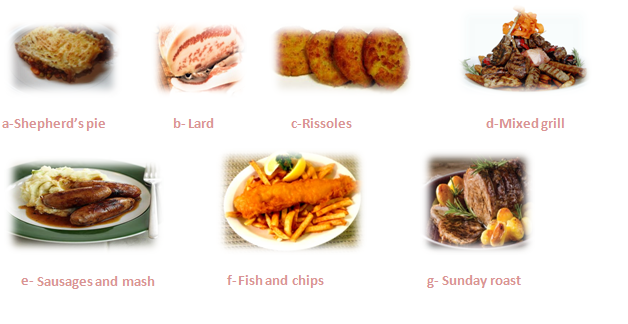
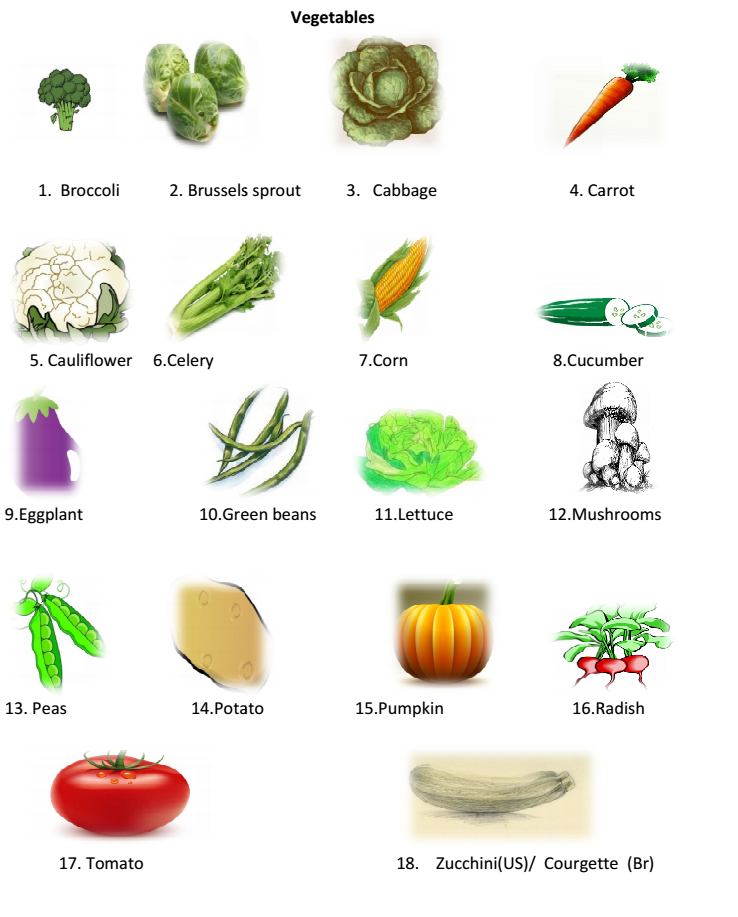
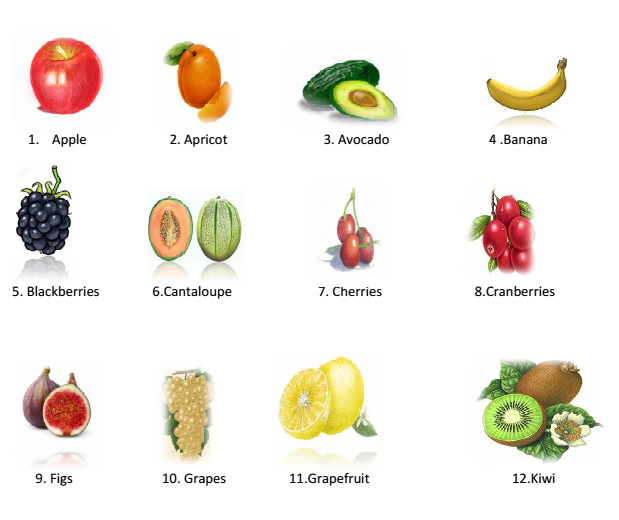

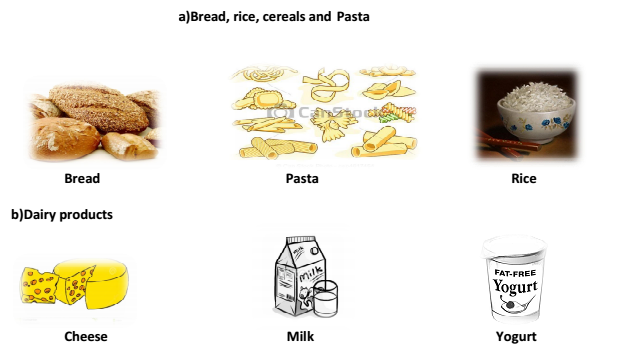
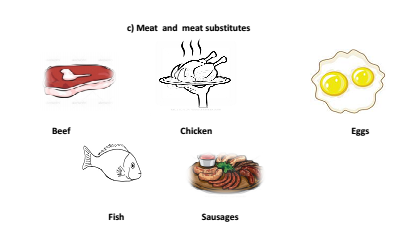

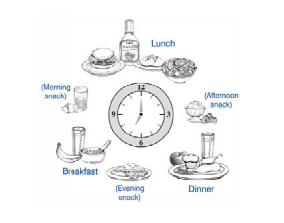
There are three main meals in a day: breakfast in the morning, lunch at midday and dinner in the evening. We also have snacks between meals. Each country has specific dishes and even the way people take their meals is different from one country to another.
The traditional English breakfast for example is richer than the Algerian one. The English have a lighter lunch if compared to the French and Algerians and their dinner is basically meat and vegetables.
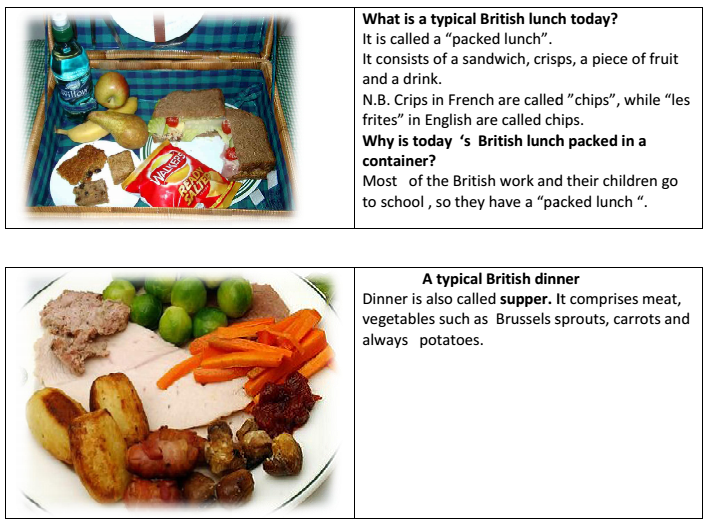
Text 3:
Today fast food chains are a global phenomenon - fried chicken, burgers and submarine sandwiches are available on the streets of New York, Edinburgh, Paris and Shanghai. While food shortages are still widespread in many parts of the world, for a lot of people in the West, the idea of eating only three meals a day is a thing of the past. We graze our way through the day, nibbling on crisps or chocolate to keep us going between meals. Obesity is on the rise in many developed and developing countries, including Britain. At the same time, the number of people who are vegetarians and the health and organic food markets are growing. Where once these eating trends were regarded as alternative, now they are mainstream. From cookery programmes on television to recipes in magazines and on websites, we're bombarded with advice on what and how to cook. But who are these programmes and publications aimed at? Do you think these are an indication that people spend more or less time cooking than in the past?
Say if the statements below are true or false
a)We can find fast food everywhere.****
b)The world population does not suffer from hunger today.****
c) In the past, we didn’t use to eat between meals .****
d)Health and organic markets are still regarded as alternative.****
- True
- Justification:” fried chicken, burgers and submarine sandwiches are available on the streets of New York, Edinburgh, Paris and Shanghai.”
- False
- Correction: ” Food shortages are still widespread in many parts of the world”. It means that many countries find difficulty in providing their populations with sufficient quantities of food.
- True
- Justification: “We graze our way through the day, nibbling on crisps or chocolate to keep us going between meals”. Today, we tend to eat crisps and Chocolate before lunch and dinner.
- False
- Correction:” The health and organic food markets are growing. Where once these eating trends were regarded as alternative, now they are mainstream”.Organic and healthy foods are no longer new to consumers ,they have become part of their eating habits.
Choisir la réponse correcte de la liste
- Today fast food chains are a global phenomenon. ****
- Food shortages are: ****
- Food shortages are still widespread in many parts of the world. ****
- Three meals a day ****
- Nibbling on crisps or chocolate to keep us going between meals. ****
- These eating trends were regarded as alternative. ****
- now they are mainstream ****
Examples from the text
a) Obesity is on the rise .
Obese (adj) + ity = obesity
Obesity (n) = when someone is very fat in a way that is unhealthy.
b) The number of people who are vegetarians are growing.
Vegeta + rian = vegetarian
Vegetarian (n) = someone who doesn’t eat meat or fish.
c) cookery programmes on television
cook(v) + ery = cookery
cookery (n) = the art of cooking
An adjective ending in suffix “ic”
d) organic food markets are growing.
Organ (n) + ic = organic.
Organic (adj) = relating to farming or growing food without using artificial chemicals.
Suffixes generally have a meaning. We add them to words to form nouns, adjectives, adverbs or verbs. In the examples above we have some nouns formed from verbs, adjectives or nouns, while we have an adjective whose basis is a noun.
|
Suffixes for forming nouns |
Meaning |
Example |
|
Verb+ ance/ ence
Person affected by an action Or acting
Somebody or something that performs an action
Relating to
Place where an action is carried out. Or art of / practice of Or state
Condition/ state Or Domain
refers to a period of time or state Or belongs to a specific group
Showing qualities of Or specific doctrine
Adjective + ity
Result / means of an action
A quality/ state/ character
State of being, status, office Or Skill, proficiency |
|
The sentences: Observe how we use them in some examples
a) Nouns ending in “ance/ ence”
- You have shown us that you are an honest person. You have won our confidence.
- Charities help the needy, especially when in winter. They always offer their assistance by providing them with clothes and food.
b) Nouns ending in “ry / ery”.
- Every day, she goes to the bakery to buy some bread and cakes.
- You need to buy a cookery book if you want to learn how too cook.
c) Nouns ending in “er / or / ess / ist / ee / ian”.
- He is a musician. He plays the guitar. He is a guitarist.
- A physician is trained to treat people who are ill, while a physicist is a scientist who has special training in physics.
- She is not my employee. She is a trainee hairdresser.
- She is a poetess and an actress.
d) Nouns ending in “ism” and “ment”.
- The government has promised to fight racism and all kinds of radicalism.
- The best treatment for the cold is to rest and drink lots of fluids.
e) Nouns ending in ”ship / ity”
- Friendship between nations is called fraternity.
f) Nouns ending in ”dom / hood / ness”
- He has just retired, but he doesn’t want to lead a life full of boredom.
- Sir Winston Churchill was offered the Dukedom of London, but he declined this honour.
- Mother Teresa was famous for her kindness and tenderness.
- Nouns can be used as subjects and complements in sentences.
- Subject + verb + complement
- Noun + verb + noun
| Suffixes for forming adjectives | Meaning | Example |
| Ic |
|
|
| Ical |
|
|
| Ful |
|
|
| less |
|
|
The sentences: Observe how adjectives are used.
- The word “responsibility” is composed of six syllables. It is a polysyllabic word.
- He likes reading satirical magazines.
- James Bond leads an eventful life.
- Classical music is restful.
- She couldn’t sleep at all. She had a restless night.
- Adjectives are generally used before a noun:
Subject + verb + adjective + noun
Associer par un trait
A/ From the late sixties to the mid-seventies, brightly colored shirts and blouses were trendy and hippie fashion made Indian cheesecloth shirts, peasant tops, tunics and Nehru jackets popular for both men and women of the era. Space- like and futuristic fashions also became popular and many tops were made out of suede, leather, vinyl and plastic.
B/ In the fifties and sixties handbags became more of a fashion statement and would coordinate with the type of occasion one was attending, larger, more practical bags were used for shopping or a day out with family while smaller, fancier bags would be used for parties or fancy evenings out with friends. In the seventies, eighties, and even nineties, handbags and purses became more of a catch- all with women narrowing their collection down to just one or two, a more formal bag and an everyday work type bag.
C/ Flat shoes, sandals, heels and pumps with rounded toes and feminine lines were worn by women in the 1950s. Saddle shoes, white lace up shoes with brown or black leather accents, were also popular for both men and women.
D/ For men, bow ties and long ties have alternated their turns in the favor of fashion. From the twenties to the nineties the length, width, fabric, colors and patterns of neck ties have varied according to trends, but they have almost always been a necessity for men's business dress and formal wear.
E/ From the 1970s on, long, straight hair was popular for women, as well as for some men. Hairstyles were usually parted down the middle. Large puffy hair worn by Motown singers were considered stylish from 1969 on to the 1970s, and short wavy hairstyles like Jodie Foster wore in 1976 were popular too.
Adapted from http://www.thepeoplehistory.com/fashions
-
A
-
B
-
C
-
D
-
E
-
clothes
-
women’s accessories
-
Shoes
-
Men’s accessories
-
hairstyles
Choisir la réponse correcte de la liste
Choose the right answer:
The paragraphs deal with:****
The paragraphs deal with the changes that occurred in the way we have dressed throughout time.
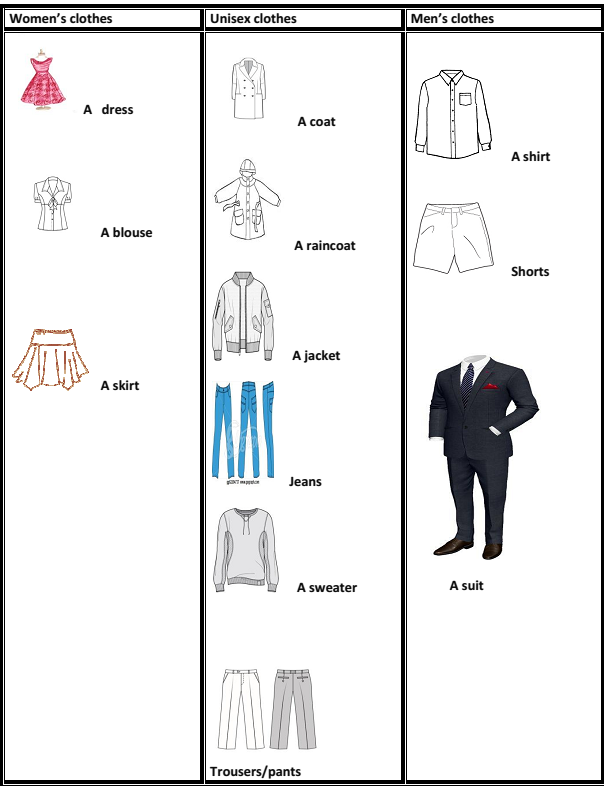
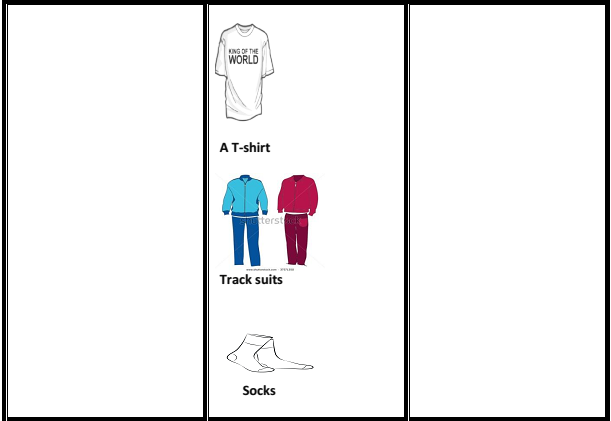
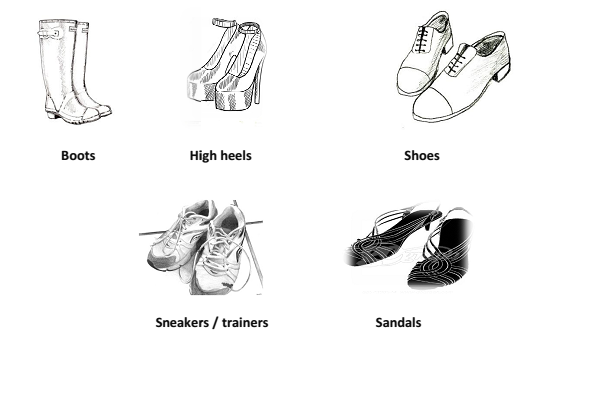
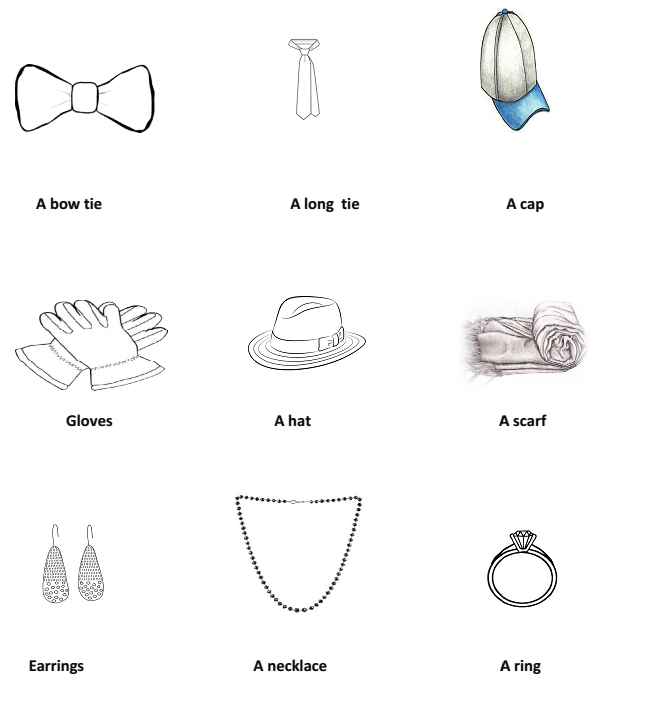
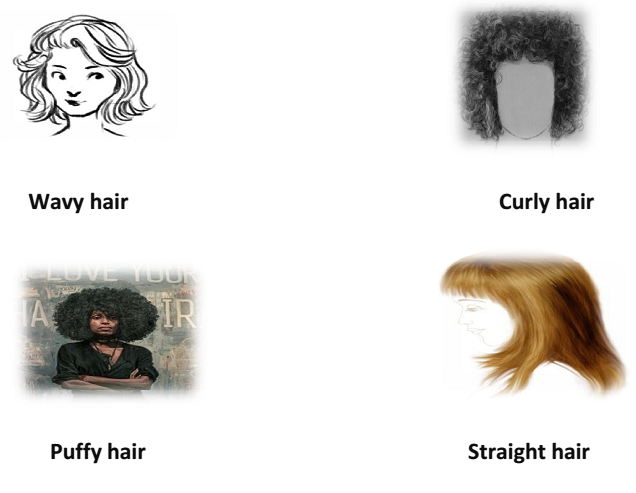
- From the late sixties to the mid-seventies, brightly colored shirts and blouses were trendy.
- Space-like and futuristic fashions also became popular.
- In the fifties and sixties larger, more practical bags were used for shopping or a day out with family while smaller, fancier bags would be used for parties or fancy evenings.
- In the seventies, eighties, and even nineties, handbags and purses became more of a catch-all, a more formal bag and an everyday work type bag.
- Flat shoes, sandals, heels and pumps with rounded toes and feminine lines were worn by women in the 1950s.
- Large puffy hair worn by Motown singers were considered stylish from 1969 on to the 1970s.
|
The adjective |
Its definition |
Example |
|
a)Brightly colored : |
having a bright colour such as red, blue, or yellow etc, or a deep shade of a particular colour, but not black, white, or plain. |
She likes wearing brightly coloured dresses.
|
|
b) Trendy:
|
influenced by the most fashionable styles and ideas.
|
Miniskirts are not trendy this year.
|
|
c)Practical:
|
useful or suitable for a particular purpose or situation [≠ impractical ] |
You must wear practical clothes if you go hiking in the mountains.
|
|
d)Fancy:
|
having a lot of decoration or bright colours, or made in a complicated way.
|
Some singers like wearing fancy clothes and shoes. |
|
e)space-like
|
very modern. |
Brian is wearing space-like shoes.
|
|
f) futuristic : |
something which is futuristic looks unusual and modern, as if it belongs in the future instead of the present.
|
This architect has specialized in designing futuristic houses.
|
|
g)catch-all: |
intended to include everything
|
Working women prefer using catch-all bags.
|
|
h)Formal: |
formal dress is clothing such as a tuxedo for men or a long dress for women, that is worn to formal events # casual clothes.
|
Classy people wear formal clothes.
|
|
i)Flat: |
flat shoes have very low heels.
|
Flat shoes and high heels are not healthy for feet.
|
|
j)Everyday :
|
ordinary, usual, or happening every day.
|
I like wearing everyday trousers.
|
|
K)Rounded: |
having a round shape.
|
Rounded bags are very trendy.
|
|
l)Stylish: |
attractive in a fashionable way.
|
Stylish people follow Paris fashion.
|
- إختبارات
- 13
- الأجوبة الصحيحة
- False
- الأجوبة الخاطئة
- False
- مجموع النقاط
- False
المراتب الخمس الأولى في Quiz
- Abadou op18
- 200 نقطة
-

- mahdi Ayat
- 177 نقطة
-

- بأخلاقي أميرة
- 154 نقطة
-

- CHAKIB SELAMI
- 129 نقطة
-

- منال طرافي
- 126 نقطة
-

- khawla youb
- 120 نقطة
-

- غزالة الباتول جنيدي
- 115 نقطة
-

- رجاء طيبي
- 91 نقطة
-

- Amina KADI
- 60 نقطة
-

- صهيب مسكين
- 45 نقطة
-

المراتب الخمس الأولى في التمارين
- Abadou op18
- 7 نقطة
-

- Fatiha Boudoukha
- 7 نقطة
-

- سيرين كنوش
- 6 نقطة
-

- Dag Lyyna
- 5 نقطة
-

- insaf belkaid
- 4 نقطة
-










